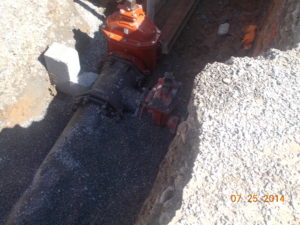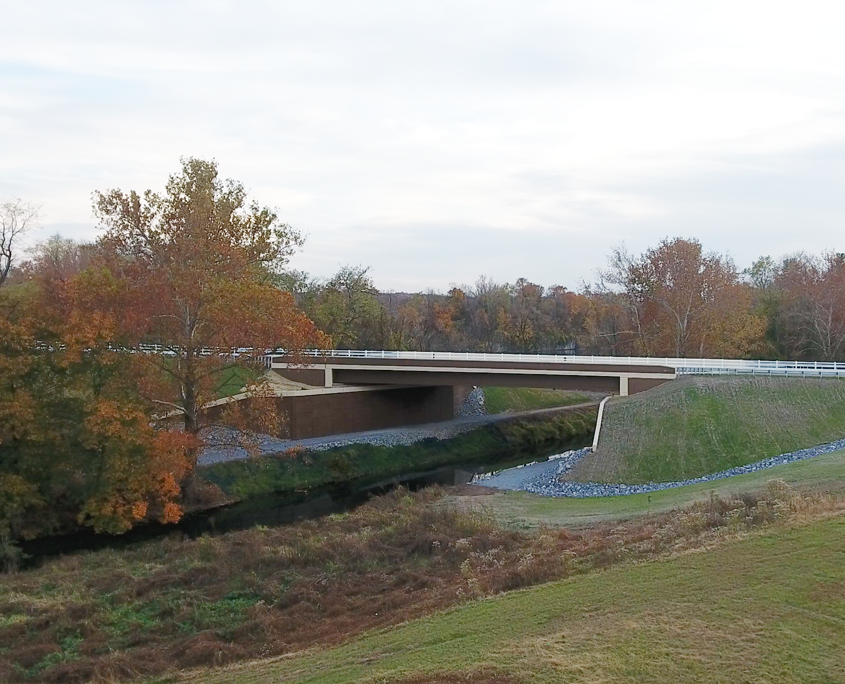Posts
How One Town Overcame Barriers to Address Aging Infrastructure and Enhance Economic Development
/in Insights-Water & Wastewater /by Judy Lincoln 
This article was published by Pennsylvania Municipal Authorities Association in the August 2017 issue of their magazine, The Authority.
Construction equipment has become a familiar sight to the residents of Middletown Borough in recent years. New businesses are popping up alongside historic buildings in the borough’s downtown business district – thanks, in large part, to a major revitalization effort spearheaded by local government officials.
And it all began by replacing the area’s water and sewer facilities.
The success of Middletown’s revitalization effort illustrates the key role infrastructure plays in building and sustaining great communities. Borough officials and local business leaders wanted to enhance economic development by attracting new businesses to downtown Middletown, but water and sewer problems threatened to kill the success of their efforts before they’d begun. Many communities could’ve seen their dreams derailed by an obstacle like this, but the borough persevered because of strategic planning and the collective effort of a community united behind a common goal. The borough’s story illustrates how communities can overcome barriers and successfully address aging infrastructure in order to enhance economic development.
Aging Infrastructure Presents a Barrier to Development
The Borough of Middletown has the distinction of being the oldest community in Dauphin County. The town was first laid out along the Susquehanna River and Swatara Creek before the Revolutionary War, and brick sewers in the historic downtown area were first installed not long after the Civil War.

Some of Middletown’s water and sewer lines dated back before 1900.
Unfortunately, the sanitary sewer and water facilities located in the downtown business district were not supporting current demand (and they certainly weren’t adequate to meet the demands of new development). The condition of the assets were a risk to the downtown revitalization efforts. In addition, cross-connections between the sanitary sewer system and the storm sewer system led to surcharging and sanitary sewer back-ups.
These challenges made it hard to keep existing businesses downtown and attract new ones. In addition, the borough was planning a streetscape project that would place numerous aesthetic improvements directly above the aging water and sewer facilities. The community did not want to see their investment in these improvements threatened by excavation to repair the sewer and water facilities soon after construction was complete.
Water and Sewer Improvements Lay the Foundation for Future Development
Borough officials asked Herbert, Rowland & Grubic, Inc. to design upgrades to the water and sewer facilities in the heart of its downtown business district (along South Union Street from Spring Street to Ann Street). This project was to be the first phase of its downtown revitalization plan. It included:
- Replacing deteriorated brick sanitary sewer mains with 1,467 feet of new PVC sanitary sewer main
- Eliminating hydraulic “bottle-necking” that restricted sewer flows to the Mill Street Interceptor
- Replacing 7 deteriorated manholes with new precast concrete manholes
- Replacing 44 sewer laterals
- Designing and replacing 2,042 feet of water main
- Replacing 4 hydrants
- Installing 14 valves to isolate future maintenance work as the community continues to upgrade its water infrastructure and to allow for future fire system services to new businesses
HRG began design work in 2013, and construction was complete in 2014. They accelerated the project schedule to reduce stress to the existing local businesses. With the risk of failing water and sewer facilities mitigated, Middletown could begin Phase II of its revitalization effort: improving the streetscape (with new decorative paving, curbing, sidewalks, and street trees) and providing traffic calming devices to promote pedestrian access to the businesses.

New sanitary sewer manhole

New sanitary sewer

New water main and valves
The Community Comes Together to Make This Project a Success
Efforts to revitalize the downtown business district had generated excitement in the community. Local leaders, business owners, and residents understood that these infrastructure upgrades were vital to attracting new business to the area, and they embraced the investment this project would require.
The former Middletown Borough Authority, the borough, and the Middletown Borough Industrial and Commercial Development Authority led the revitalization effort and engaged the public throughout the process. They held numerous meetings with the public and with local stakeholders to communicate the vision and direction of the project. The project team worked extensively with the owners of local businesses along South Union Street, soliciting their ideas and accommodating special events to minimize disruption to business activity.
Thanks, in part, to these open lines of communication, the project team was able to maintain water and sewer service to the existing businesses in the area throughout the project (despite having a confined working area due to the presence of numerous other utilities).
The engineers also coordinated extensively with other project partners to ensure a smooth transition from Phase I (water and sewer improvements) to Phase II (streetscape enhancements). For example, they coordinated extensively with the streetscape design team to ensure that the water and sewer improvements would not conflict with proposed streetscape facilities, and they worked closely with the landscape architect to ensure that above-ground features like hydrants and manhole covers were installed at locations that would not impact the streetscape visual design concepts. This saved the borough money and ensured that above-ground features would not have to be relocated during Phase II to achieve the aesthetic goals of the streetscape enhancements.
Detailed records about the location and depth of sewer laterals by HRG’s resident project representatives during construction of Phase I provided further cost savings. This information was used for deciding the depth of stormwater facilities in Phase II, reducing design fees in that phase. It also prevented costly change orders that often come from unknown utility locations.

The Improvements Begin to Generate New Development Interest
It didn’t take long for all of this activity to generate interest from developers and business owners in opening new ventures in the area. While the project was in its construction phase, a developer proposed a 100-room hotel with retail space on the first floor just a block away from downtown. The developer also expressed an interest in working with the team behind the streetscape design to develop other projects in the area. He specifically mentioned the downtown revitalization efforts as one of the factors in his decision to invest in the area.
Patrick Devlin of the Tattered Flag Brewery and Still Works also mentioned the flurry of activity downtown as a factor in choosing to locate his business in the old Elks Building. The brewery opened in December 2016 and was recently named the New Business of the Year by the Harrisburg Regional Visitors Bureau.
Business investment like this is expected to continue in Middletown and the surrounding communities. The new sewer infrastructure mitigated a known risk, increased efficiency, and gave the borough additional capacity for the anticipated development.
The water and sewer improvements were completed two weeks ahead of schedule and almost $400,000 under budget. This new infrastructure proved to have a much lower maintenance and operations cost than the aging infrastructure it replaced, and it has drastically reduced infiltration and inflow into the system. During an early phase of design, engineers found and eliminated a cross-connection between the aging sanitary sewer and the borough’s storm sewer system. By eliminating this cross-connection, they were able to prevent approximately 500,000 gallons of stormwater from entering the sewer system during a typical rain event. In fact, since the project was completed, the system has not experienced a single sanitary sewer overflow, and no sewer back-ups have been reported along North Union Street. (You can read more about the correction of this cross-connection here.)
Investing in a project of this magnitude is hard for many communities, but Middletown’s story shows it is possible and the benefits are wide-ranging. When well planned and executed, updated infrastructure lowers maintenance and operations costs, enhances the quality of service to a system’s customers, and helps to attract growth and investment in the community. When citizens and business owners join forces with the local government and think creatively, the seemingly impossible task of upgrading our aging infrastructure while promoting economic development becomes possible!
 Josh Fox, P.E., is the regional manager of water and wastewater services in HRG’s Harrisburg office. He is responsible for the completion of studies, designs, and construction contract administration for a wide variety of water and wastewater treatment facilities. He served as project manager for these water and sewer improvements in Middletown, which were honored by Dauphin County in 2017 with a Premier Project Award.
Josh Fox, P.E., is the regional manager of water and wastewater services in HRG’s Harrisburg office. He is responsible for the completion of studies, designs, and construction contract administration for a wide variety of water and wastewater treatment facilities. He served as project manager for these water and sewer improvements in Middletown, which were honored by Dauphin County in 2017 with a Premier Project Award.
Duke Street Bridge Honored with Safety Award
/in Company News, News-Transportation /by Judy Lincoln
Wider bridge improves access for emergency vehicles and pedestrians while reducing the likelihood of car accidents
The Duke Street Bridge replacement has been honored with a Road & Bridge Safety Award from the Pennsylvania Highway Information Association, County Commissioners Association of Pennsylvania, and PennDOT.
Herbert, Rowland & Grubic, Inc. designed the project for Dauphin County, which improves safety for local residents in several ways:
- It improves emergency access for residents who live near the bridge. The original Duke Street Bridge couldn’t carry vehicles weighing more than 3 tons, which meant most of the vehicles operated by the Hummelstown Borough Fire Company and Union Deposit Fire Company couldn’t use the bridge. The new bridge has no weight restrictions, and emergency vehicles can safely cross it (as shown in the attached photo).
- It safely accommodates two lanes of traffic, whereas the original Duke Street Bridge was only wide enough for one lane of traffic at a time.
- It makes it safer for drivers to turn onto South Hoernerstown Road from North Duke Street, thanks to increased intersection radii. Previously drivers of large vehicles turning right onto South Hoernerstown Road from Duke Street would cross into the opposing lane. Limited sight distance at this location meant that opposing traffic could not see these vehicles crossing over into their lane with optimum time to react. The new wider intersection will drastically reduce the likelihood of accidents at this location in the future.
- It provides a new sidewalk. The previous Duke Street Bridge had no existing sidewalk; accordingly, pedestrians would often walk in the roadway lanes to cross from one municipality to the other. The new bridge includes a sidewalk that will enhance safety for pedestrians trying to access the United Water Trailhead and Swatara Creek Trail.
ABOUT HRG
Founded in 1962, HRG has grown to be a nationally ranked Top 500 Design Firm, providing civil engineering, surveying and environmental services to public and private sector clients. The 200-person employee-owned firm currently has office locations in Pennsylvania, Ohio, and West Virginia. For more information, please visit the website at www.hrg-inc.com.
Adrienne Vicari Named One of Central PA’s Top 40 Under 40
/in Company News, News-Financial, News-Municipal, News-Water & Wastewater, News-Water Resources /by Judy Lincoln The Central Penn Business Journal named Adrienne Vicari to its 23nd annual Forty Under 40 list, which honors individuals for their commitment to business growth, professional excellence and the Central Pennsylvania community. She and the other honorees will receive their award at a banquet on October 2 at the Hilton Harrisburg.
The Central Penn Business Journal named Adrienne Vicari to its 23nd annual Forty Under 40 list, which honors individuals for their commitment to business growth, professional excellence and the Central Pennsylvania community. She and the other honorees will receive their award at a banquet on October 2 at the Hilton Harrisburg.
Adrienne is the financial services practice area leader at Herbert, Rowland & Grubic, Inc. She has more than 15 years of experience in financial consulting, project management and engineering design for municipal wastewater, water and stormwater clients. In her current role with the firm, she uses asset management and capital improvement planning as tools to complete long-range strategic financial planning for her clients.
But she began her career at HRG in a very different role: as a professional engineer designing water and wastewater treatment facilities. She quickly developed an interest in helping her water and wastewater clients obtain and manage their funding for capital improvement projects and transitioned into the firm’s financial service group. As communities have developed a growing need for increased stormwater management funding and utility valuation, she has become an industry leader in these areas, as well.
Russ McIntosh, a vice president of HRG, says:
“Adrienne is an unstoppable force. When she sees something needs done, she dives right in and gives it everything she has. She is extremely knowledgeable of the issues municipal water quality professionals face and very creative in addressing those challenges. There is nothing she can’t or won’t do to help her clients succeed.”
 This dedication extends outside the office to the Central Pennsylvania community, as well. Adrienne encourages young people to achieve success in science, technology engineering, and math related fields by participating in STEM-related events like the “Introduce a Girl to Engineering Day” at the Whitaker Center. She also serves as a board member with the Girl Scouts in the Heart of Pennsylvania organization and takes part in their annual STEM expo. In addition, she coaches Central Penn Mini Sticks field hockey and a Cumberland Valley softball 10U team.
This dedication extends outside the office to the Central Pennsylvania community, as well. Adrienne encourages young people to achieve success in science, technology engineering, and math related fields by participating in STEM-related events like the “Introduce a Girl to Engineering Day” at the Whitaker Center. She also serves as a board member with the Girl Scouts in the Heart of Pennsylvania organization and takes part in their annual STEM expo. In addition, she coaches Central Penn Mini Sticks field hockey and a Cumberland Valley softball 10U team.
She also co-founded a women’s volunteer group for West Shore mothers that encourages them to pursue diverse volunteer opportunities with their children. The group has had a significant impact on mid-state organizations such as Caitlin Smiles, Leg Up Farm, Ronald McDonald House, Dress for Success, and others.
ABOUT HRG
Originally founded in 1962, HRG has grown to be a nationally ranked Top 500 Design Firm, providing civil engineering, surveying and environmental services to public and private sector clients. The 200-person employee-owned firm currently has office locations in Pennsylvania, Ohio, and West Virginia. For more information, please visit the website at www.hrg-inc.com.
How to Mitigate Flood Risk (and How to Get Funding to Support the Effort)
/in Insights-Local Government, Insights-Municipal, Insights-Water Resources /by Judy LincolnErin Letavic, a project manager in HRG’s civil group, published an article in the July issue of Borough News magazine about flood control entitled “Mitigating Flood Risk in Your Borough.” In it, she discusses the costs municipalities face when flooding occurs and offers tips for how to minimize the risk of flood damage as much as possible.
Topics she discusses in the article include
- Understanding your community’s flood risk
- Improving floodplain management in your community
- Expanding vegetation that absorbs flood waters and filters pollutants
- Promoting the construction of green infrastructure
- Obtaining funding for flood mitigation measures
- Gaining public support for flood mitigation measures
Here’s a preview of the tips she offers in the video below:
Severe floods can happen in any community, and, when they do, they can wreak serious havoc: destroying homes and businesses, threatening people’s safety, temporarily shutting down the economy, and damaging infrastructure.
Communities can manage flood risk by implementing a flood mitigation strategy. The first step in flood control is to determine what areas of your community are most vulnerable to flooding and model exactly how those areas would be impacted by particular flood events. The next step is to make sure your ordinances and codes limit development in flood-prone areas and promote the planting and preservation of vegetation that will absorb flood waters and reduce flood intensity.
Successful flood control plans require cooperation among all stakeholders in a community, so it is essential to involve them throughout the planning and implementation stages. Obtaining grants and loans to support the initiative will help reduce opposition and lessen the impact on tight municipal budgets.
While the risk of flood damage cannot be completely eliminated, municipalities can greatly enhance the safety of their communities with a forward-thinking approach. The planning a municipality does today is key to weathering the storms tomorrow may bring.
Read the entire article here or in the print edition of Borough News magazine.
Park Boulevard Realignment in Hershey Honored with Safety Award
/in Company News, News – Government, News-Municipal, News-Transportation /by Judy Lincoln
Representatives of Derry Township in Dauphin County accept the first-place roadway award in the Road and Bridge Safety Improvement Awards at the Pennsylvania State Association of Township Supervisors’ (PSATS) 95th Annual Educational Conference April 23-26 in Hershey. Sponsored by PSATS, the Pennsylvania Highway Information Association (PHIA), and the state Department of Transportation, the award recognizes townships for their extensive contributions to making roads and bridges safer. Participating in the presentation are, from left, PennDOT Director of Planning and Research Laine Heltebridle; Matthew Lena, P.E., transportation team leader, Herbert, Rowland & Grubic, Inc.; Derry Township Chairman John Foley; PHIA Managing Director Jason Wagner; and PSATS Executive Board Member Bill Hawk. (Photo courtesy of the Pennsylvania State Association of Township Supervisors.)
The realignment of Park Boulevard has been honored with a Road & Bridge Safety Award from the Pennsylvania Highway Information Association, Pennsylvania State Association of Township Supervisors, and PennDOT. The award was presented to Derry Township officials at the Pennsylvania State Association of Township Supervisors Conference at the Hershey Lodge on April 24, 2017.
Herbert, Rowland & Grubic, Inc. designed the project for Derry Township and devised a creative funding strategy that expedited the project schedule.
A broad range of local leaders from Derry Township, Dauphin County, and area businesses worked together on this project to support future economic development in Hershey. The new roadway provides several safety improvements:
- It replaces a 60-year old bridge over Spring Creek, which was structurally deficient and weight-restricted.
- It converts a narrow roadway beneath the Norfolk-Southern underpass from two-way traffic to one-way traffic. (The roadway is not wide enough for two opposing lanes of traffic to safely pass each other, so switching to one-way traffic will prevent vehicle conflicts.)
- It improves emergency response time by adding a roadway connection from northbound Park Boulevard. (Previously, first responders had to drive a circuitous route through several intersections to access this area. Now crews can reach the area 2-3 minutes faster.)
- It provides a new sidewalk that will enhance safety for pedestrians traveling to Hershey’s attractions from downtown.
- It adds a safe zone for people boarding and exiting buses at the Hershey Intermodal Transportation Center. This zone is physically protected from through-traffic.
The realigned Park Boulevard was completed and opened to traffic in the fall of 2016. View a slideshow of project photos below.
Dauphin County Infrastructure Bank Honored with Governor’s Award
/in Company News, News-Financial, News-Municipal, News-Transportation /by Judy LincolnHerbert, Rowland & Grubic, Inc. (HRG) is pleased to announce that our client Dauphin County received a Governor’s Award for Local Government Excellence for the infrastructure bank program we helped them create. The award for “innovative community or government initiative” was presented to Dauphin County officials at the Governor’s Residence on April 12, 2017. Commissioners George Hartwick, Jeff Haste, and Mike Pries attended the ceremony with George Connor, the executive director of Dauphin County’s Department of Community and Economic Development and the administrator of the infrastructure bank program.
HRG worked with PennDOT and Dauphin County officials to develop this program, which provides a creative solution to one of local government’s biggest challenges: successfully maintaining and replacing infrastructure. It leverages the county’s Liquid Fuels funding and the underutilized Pennsylvania Infrastructure Bank program to stretch the value of local government dollars. In its first three years, Dauphin County turned an annual investment of $325,000 in Liquid Fuels money into 10 projects worth $11 million: 7 bridges, 1 streetscape, 1 intersection improvement, and 1 traffic signal improvement.

While people on both sides of the aisle agree that infrastructure improvements are badly needed, the debate often stalls over where the money will come from to pay for these improvements. The Dauphin County Infrastructure Bank shows that new revenue is not necessarily needed to begin addressing these problems; applying existing revenue in new ways can help us make significant progress. By combining several sources of funding – each of which would’ve been inadequate to meet the infrastructure need alone – the Dauphin County Infrastructure Bank has accomplished so much more for the county’s residents than these funding sources could’ve done individually.
Brian Emberg is an engineer who helped develop this program. He began working with the county in the 1980s on a similarly forward-thinking program that helped the county eliminate significant structural deficiency of its bridges. (In 1984, one-third of the county’s bridges were structurally deficient, but today the county has no load-posted, structurally deficient bridges at all, thanks to a bridge management system they designed with HRG.)
Emberg says, “Dauphin County’s officials are dedicated public servants and true visionaries. They continually challenge the status quo to deliver the best service to their constituents for the highest return on public tax dollars. This program provides a great example to other counties on how the seemingly impossible task of addressing our infrastructure can be solved.”
Indeed, HRG is currently in talks with counties around the state about implementing similar infrastructure bank programs of their own. Though Dauphin County uses its program for transportation improvements, the program can be used to fund any type of infrastructure, depending on the sources of money used to capitalize the loan program.
Funded by the Dauphin County Infrastructure Bank: Middletown Borough Streetscape

Funded by the Dauphin County Infrastructure Bank: Londonderry Township culvert

HRG and Land Studies to Prepare Paxton Creek TMDL Plan
/in Company News, News – Government, News-Environmental, News-Municipal, News-Water Resources /by Judy Lincoln HRG is partnering with LandStudies, Inc., to prepare a TMDL plan for Paxton Creek beginning in the spring of 2017.
HRG is partnering with LandStudies, Inc., to prepare a TMDL plan for Paxton Creek beginning in the spring of 2017.
The Paxton Creek TMDL Plan will be like a “pollution diet” for the watershed. It will outline how much sediment is in the creek now, identify potential sources of that pollution, and provide strategies for reducing sedimentation to safer levels by a specified deadline. The overall goal of the TMDL plan is to help municipalities within the watershed comply with relevant state and federal regulations while improving the health of Paxton Creek.
HRG was involved in the preparation of the Paxton Creek Watershed TMDL Strategy in December 2015 and is the retained engineer for CRW, Susquehanna Township, and Lower Paxton Township. These experiences provide HRG with historical knowledge of the pollution issues within the watershed that other firms do not have. LandStudies has the state’s first Certified Professional in Municipal Stormwater Management (CPMSM), who is well-versed in writing TMDL plans and assisting municipalities with their stormwater pollution problems.
Premier Projects: Dauphin County Honors Middletown Sewer & Cal Ripken Field
/in Company News, News – Government, News-Land Development, News-Municipal, News-Water & Wastewater /by Judy LincolnHerbert, Rowland & Grubic, Inc. (HRG) is pleased to announce that two of our projects have been selected by Dauphin County in its annual Premier Projects award program.
Since its inception five years ago, the Dauphin County Premier Projects program has honored 23 projects that promote smart growth and spark revitalization throughout the region. Among this year’s six honorees, HRG provided engineering services for two of them: the replacement of sanitary sewer facilities in Middletown’s downtown business district and the construction of a state-of-the-art youth baseball field at the Harrisburg Boys and Girls Club.
Middletown Sewer Replacement

| (Left to right) County Commissioners Mike Pries and George Hartwick,III, HRG Staff Professional Staci Hartz, Middletown Public Works Superintendant Ken Klinepeter, and Tri-County Regional Planning Commission Executive Director Tim Reardon |
The replacement of Middletown’s sanitary sewer lines played a crucial role in promoting renewed economic development along South Union Street, which is the heart of the borough’s business district. Some of the sewer mains in this area were close to 100 years old and had deteriorated enough that community and business leaders feared a collapse could endanger streetscape improvements in the area. This project successfully replaced aging infrastructure and eliminated a cross-connection between the borough’s sanitary and stormwater systems that had caused several sewage overflows near Hoffer Park as well as sanitary sewer back-ups in businesses along South Union Street. Without excess water entering the system during wet weather events, the sewer authority has additional capacity available and is able to extend service to nearby growing communities in Londonderry Township and Lower Swatara Township (which, in turn, can promote further economic development in those areas, as well.)
Cal Ripken Senior Youth Development Park

| (Left to right) County Commissioners Mike Pries and George Hartwick,III, HRG Eastern Region Vice President Andrew Kenworthy, Harrisburg Boys and Girls Club Director of Development Blake Lynch, and Tri-County Regional Planning Commission Executive Director Tim Reardon |
The Cal Ripken Senior Youth Development Park at the Harrisburg Boys and Girls Club provides recreation and character development opportunities for disadvantaged youth. The park was funded through the Cal Ripken Senior Foundation, which supports the development of baseball and softball programs in distressed communities. This initial donation inspired other businesses and community organizations to pledge their own financial support for the athletic facility and its programs, which include Little League, a summer soccer program, speed and agility camps, flag football, and lacrosse.
The facility is located in an economically disadvantaged section of the city and is the only active athletic field available for youth in that area. As such, it offers kids a safe space for recreation to keep kids busy and engaged in healthy pursuits.
ABOUT HRG
Originally founded in 1962, Herbert, Rowland & Grubic, Inc. (HRG) has grown to be a nationally ranked Top 500 Design Firm, providing civil engineering, surveying and environmental services to public and private sector clients. The 200-person employee-owned firm currently has office locations in Pennsylvania, Ohio, and West Virginia. For more information, please visit the website at www.hrg-inc.com.
HRG Named a Utility Valuation Expert by the PA Public Utility Commission
/in Company News, News-Financial, News-Water & Wastewater /by Judy LincolnMany municipalities are considering selling their water and wastewater systems in order to address long-term budget and debt obligations. As one of PA’s first Utility Valuation Experts, HRG is ready to help municipalities attain fair market value for these assets.

Herbert, Rowland & Grubic, Inc. (HRG) was recently recognized by the Pennsylvania Public Utility Commission as a Utility Valuation Expert. Under legislation signed by Governor Tom Wolfe in 2016, municipalities wishing to sell their utility assets to a PUC-regulated utility can engage the services of a registered Utility Valuation Expert to determine fair market value of their system.
The program is voluntary, but it benefits both the municipality and the potential buyer by presenting a more accurate picture of a utility’s value than the traditional method.
In Pennsylvania, the purchase of water and wastewater systems by a regulated utility must be approved by the Public Utility Commission. Traditionally, the commission has considered the value of a system to be equal to its depreciated original cost (construction cost minus grants and depreciation). This approach did not consider the potential income that could be generated from the assets and frequently resulted in valuations so low that municipalities couldn’t benefit from a sale.
At the same time, with no consideration to the market or revenue, potential buyers could not be sure whether they would achieve an adequate return on their investment with the purchase.
To remedy these problems, Act 12 of 2016 created a new, voluntary approach to utility valuation based on fair market value. Under this system, the buyer and the seller each retain a registered Utility Valuation Expert to conduct independent appraisals of the utility using industry standards: cost, market, and income approaches. These appraisals use data on the physical system assets that was assessed by a professional engineer retained by both parties.
After both appraisals are submitted, an average of the fair market value calculated in each one is used as the final valuation.
HRG was one of the first firms to be listed on the PUC’s official Registry of Utility Valuation Experts. The firm specializes in providing financial services to the water and wastewater industry and has conducted numerous system reviews and valuation studies for municipalities throughout the state. Vice President Russ McIntosh has published dozens of articles on water and wastewater system financing and was honored by the Pennsylvania Municipal Authority Association for outstanding contributions and exceptional service to the industry in 2014. McIntosh has also served as an expert witness on matters of utility financing in several court cases.
“Our goal at HRG is to provide a fair and honest accounting of a utility’s value, so that the municipality can decide what is best for the long-term health and financial stability of its community,” McIntosh says. “We can go beyond mere valuation to help communities weigh all of their options for generating the money they seek to address budget needs while protecting the value of their most important assets.”
For more information about the utility valuation process defined in Act 12 of 2016, please contact Russ McIntosh at (717) 564-1121 or rmcintosh@hrg-inc.com.




